Dec 30, 2025
Dec 30, 2025
I had always been fascinated by this great country called China, right from my early childhood.
I studied with great admiration the great Chinese traveler and Philosopher Hieun Tsang who visited India and lived in India from 627 AD to 643 AD.
Ever since, I had this urge of visiting this great country. Both my wife and I have a penchant for traveling and we have a group of friends who share the same. So, while we strive to travel to one or the other location, this time, we zeroed in on China.
I took the onus of finding the right tour operator and being a huge country, we had to prioritize the cities and sites that we must visit during a short nine day trip.
The process of finalization of tour plans and budget was done over a period of five to six months.
Finally, all preparations done and we set out on our dream tour to “The Peoples’ Republic of China”.
While the enchanting tour covered several interesting sites and cities, I will dwell on the salient and most fascinating places that we visited.
Beijing:
Was quite awestruck and the sheer magnitude and development of this mega polis the Capital City of China. A sprawling city bustling with people! But the whole city was so well organized, the city traffic very disciplined, the road and the rail transport system was “immaculate” to say the least. The Underground railway system too was planned and punctual, where the trains adhere to the timings by seconds.
A few years ago, I had read that Beijing was one of the most polluted cities in the world and that people suffered respiratory problems like we have seen in the Indian Capital, New Delhi.
However, upon driving through the city, we noticed no pollution at all. When I enquired with our Tour guide, he told me that the Government had initiated decisive steps to bring down the pollution levels.
They plant one million saplings every year and today 48% of Beijing city is green, they have also relocated some major industries that were contributing the City’s pollution.
We noticed that only battery operated two wheelers were used. They provide separate tracks for two wheelers, to ensure their safety.
Cleanliness and housekeeping has become a part of the culture. We never could see any garbage of pieces of paper in any part of the city, despite being one of having a very dense population.
It just goes to show, that such great achievements can be made, if there is
1. Political Will
2. People’s determination/discipline
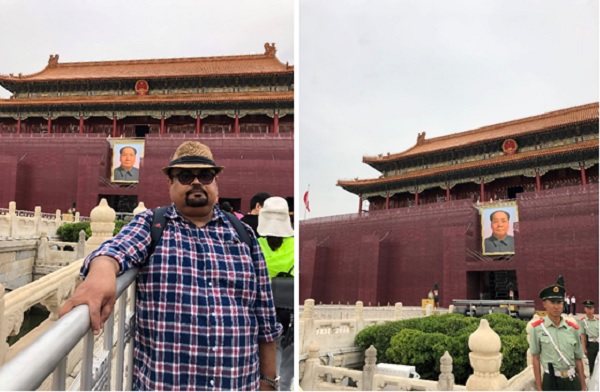
One of the most important sites that was on my “bucket list” was a visit to the Tiananmen Square, which is located in the center of the Chinese Capital. It is the largest city square in the world, even larger than the famous Times Square in New York. During April 1989, over one million students had gathered together at the square for a peaceful demonstration for pro-democratic reforms in China. This was met with a violent crushing of the event by the Chinese Security Forces armed with assault rifles, tanks and water cannons. While there is no consensus on the actual death toll, the estimates range to around 10, 000 students being killed at the square. China has effectively erased the event from its collective memory and suppressed common knowledge of the massacre.
As a young man in my twenties, I had watched the brutality of the military action on Television and those harrowing scenes had left an indelible mark in my heart.
I felt a strange pang of sorrow when we trod on the beautiful ground of that very historic Tiananmen Square. I offered a silent prayer for those young souls who had sacrificed their lives on that fateful day of June 1989, (incidentally the same month of our visit), 30 years ago.
The next and one of the “high points” of our China trip was the visit to “The Great Wall”.
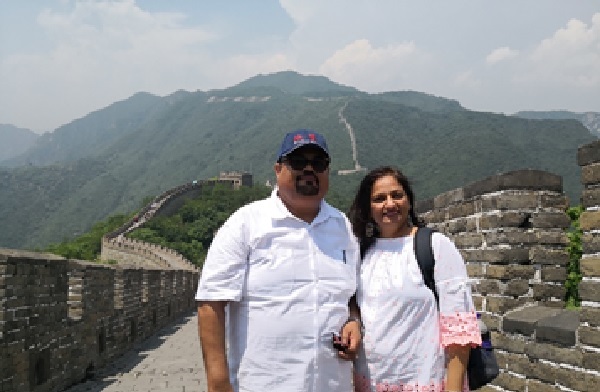
The Great Wall of China is the collective name of a series of fortification systems generally built across the historical northern borders of China to protect and consolidate territories of Chinese states and empires against various nomadic groups. Several walls were being built from as early as the 7th century BC by ancient Chinese states; selective stretches were later joined together by Qin Shi Huang (220–206 BC), the first Emperor of China. Later on, many successive dynasties have built and maintained multiple stretches of border walls. The most currently well-known of the walls were built by the Ming dynasty (1368–1644).
As per the archaeological survey the entire wall with all of its branches measures out to be 21,196 km (13,171 mi). The Great Wall is recognized as one of the most impressive architectural feats in history.
Apart from defense, other purposes of the Great Wall have included border controls, allowing the imposition of duties on goods transported along the Silk route, regulation or encouragement of trade and the control of immigration and emigration. Furthermore, the defensive characteristics of the Great Wall were enhanced by the construction of watch towers, troop barracks, garrison stations, signaling capabilities through the means of smoke or fire, and the fact that the path of the Great Wall also served as a transportation corridor.
Mutianyu is a section of “The Great Wall” located around 70 Kilometres from the city of Beijing. This is by far the most well preserved sections of the Wall.
We arrived at Mutianyu and got a brief on the visit. We learnt that there was a helicopter service that sorties tourists for an aerial view of the Wall. Most of us opted for it. We drove to the helipad. It was a small four seater helicopter. The helicopter ride lasted for all of fifteen minutes, but the sight and the view will remain deeply etched in our memory for ever. The large expanse of the Great Wall spanned over the ups and downs of the mountains was truly breathtaking. The view from the Helicopter really gives us a perspective of the magnitude of the human effort in building the Great Wall.
After we completed the Heli tour, we finally drove to the foothills of the Mutianyu section. The ride by rope car takes us to the foot of the Wall. A climb up the stairs led us to the top of the wall. Oh! What a feeling!!
The Wall is built with granite, the wall is 7 to 8.5 metres high and the top is 4 to 5 metres wide.
- Watchtowers are densely placed along this section of the Great Wall - 22 watchtowers on this 2,250-metre (7,380 ft) stretch.
- Both the outer and inner parapets are crenelated with merlons, so that shots could be fired at the enemy on both sides - a feature very rare on other parts of the Great Wall.
- The Mutianyu Pass consists of three watchtowers, one big in the centre and two smaller on both sides. Standing on the same terrace, the three watchtowers are connected to each other inside.
While I stood on this mighty wall, with my wife beside me, I could not help but wonder about the human efforts to build this wall, in those ancient days without access to modern construction equipment, made me wonder, how many lives were lost during the construction. I asked this intriguing question and was shocked to hear that over one million lives were lost during the construction of the wall and that it was also infamously called “The World’s largest Grave Yard”. The rulers were so ruthless that not just the dead but those critically injured/ill too were buried under the wall. I felt a dull pain exacerbate in my heart, when I learnt of this sad fact/story.
So, what we were seeing as a man-made wonder and an “engineering marvel” has literally witnessed the blood and lives of over a one million men and the sorrow and tears of a million families….
Xian:
The next city of our visit was to the city of Xian and the most important locations in our itinerary. Xian, though a much smaller city, in comparison with Beijing, seemed more cosy and hospitable. The city was well planned and had a portion of the Great Wall passing bisecting the city into two sides.
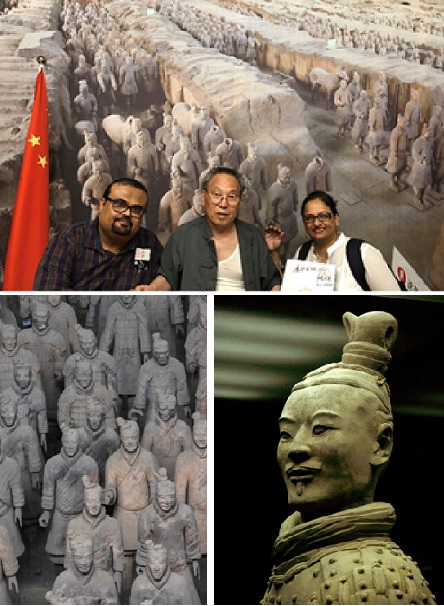
During my early school days in the year 1977, our Geography teacher one day, brought a book containing the information of the discovery of a whole “army” of Terrakota Warriors. The pictures in this book and the explanation of the story was a huge revelation to us and had captivated my imagination on my impressionable mind. I had an innate desire to visit and see this magnificent discovery…..which finally was becoming a reality!!
“The Terracota Warriors”, which is located in the Lintong County, outside Xian city, in Shaanxi Province.
The Terracotta Army is a collection of terracotta sculptures depicting the armies of Qin Shi Huang, the first Emperor of China. It is a form of funerary art buried with the emperor in 210–209 BCE with the purpose of protecting the emperor in his afterlife.
The figures, dating from approximately the late third century BC were discovered in 1974 by local farmers. The figures vary in height according to their roles, with the tallest being the generals. The figures include warriors, chariots and horses. It is estimated that the three pits containing the Terracotta Army held more than 8,000 soldiers, 130 chariots with 520 horses, and 150 cavalry horses, the majority of which remained buried in the pits near Qin Shi Huang's mausoleum. Other terracotta non-military figures were found in other pits, including officials, acrobats, strongmen, and musicians.
Four main pits approximately 7 metres (23 ft) deep have been excavated. These are located approximately 1.5 kilometres (0.93 mi) east of the burial mound. The soldiers within were laid out as if to protect the tomb from the east, where the Qin Emperor's conquered states lay.
Pit 1, which is 230 metres (750 ft) long and 62 metres (203 ft) wide, contains the main army of more than 6,000 figures.] Pit 1 has eleven corridors, most more than 3 metres (10 ft) wide and paved with small bricks with a wooden ceiling supported by large beams and posts. This design was also used for the tombs of nobles and would have resembled palace hallways when built. The wooden ceilings were covered with reed mats and layers of clay for waterproofing, and then mounded with more soil raising them about 2 to 3 metres (6 ft 7 in to 9 ft 10 in) above the surrounding ground level when completed.
Pit 2 has cavalry and infantry units as well as war chariots and is thought to represent a military guard. Pit 3 is the command post, with high-ranking officers and a war chariot. Pit 4 is empty, perhaps left unfinished by its builders.
When I saw the Warriors in the pits and as I walked down the aisle looking at those behind, I was reminded of the words of my teacher and the animated explanation of the amazing discovery.
We had a great photo opportunity to buy souvenirs and models of the warriors and also to pose for a photograph with the only surviving farmer who was a young farming assistant in his early twenties during the discovery. He is in his seventies now.
Dongfeng City:
The Shaolin Temple was one of the most important locations of the entire tour. We drove to Dongfeng City from Luoyong City. It was a long three hours drive before we reached this mountainous city of Dongfeng. It was yet another magnificent sights.
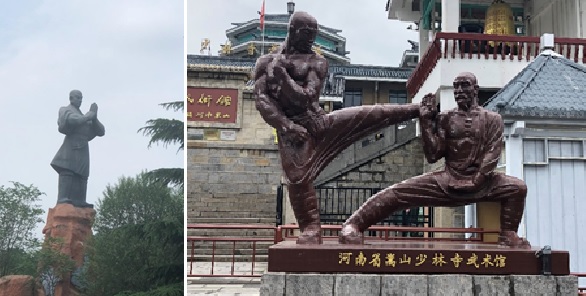 image 4
image 4
The visit to the Shaolin Temple began by witnessing a fabulous “Kungfu” show which was demonstrated by the students who were trained at the Kungfu Martial arts School as a part of their school curricula. Unfortunately this school does not accept female students.
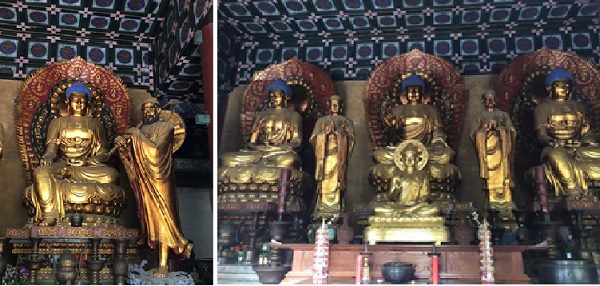
Shaolin Temple was established in 495 A.D. at the western foot of Songshan Mountain, 13 kilometers northwest to Dengfeng City, Henan Province. The then-Emperor Xiaowen of the Northern Wei Dynasty (386-557) had the temple built to accommodate the Indian Buddhist monk and master Buddhabhadra, whom they called “Batuo” in China.”.
As the first Shaolin abbot, Batuo (Buddhabhadra) devoted himself to translating Buddhist scriptures and preaching doctrines to hundreds of his followers. Thirty two years later, another Indian monk Bodhidharma arrived at Shaolin Temple, who was said to have crossed the Yangtze River on a reed. He spent nine years meditating in a cave of the Wuru Peak and initiated the Chinese Chan or Zen tradition at Shaolin Temple. Thereafter, Bodhidharma was honored as the first Patriarch of Chan Buddhism. As Chinese Kungfu also originated from Shaolin Temple, it has been recognized as the origin of Chan Buddhism and the cradle of Kungfu.
Besides, it is known that martial arts have been practiced at the temple throughout its history. A legend had it that Bodhidharma found monks weak and unhealthy after long time meditation practices, so he developed the martial arts to strengthen them, which formed the basis of Shaolin Kungfu. However the unique aspect of Shaolin culture is the combination of Shaolin Kungfu and Chan Buddhism.
The Shaolin Temple has beautiful statues of the Buddha. One feels a deep sense of piety in the precincts of the temple. My wife and I, joined the devotees to light and incense stick, kneel and pray to the Buddha.
The experience gave me and Sneha a deep sense of calm and peace.
While the whole China trip was enchanting with vivid and varied experience in various towns and cities, it is these ancient cities with rich history that had really captivated my interest. The sprawling metropolis of Beijing, the trade and finance capital of China – Shanghai were equally fascinating.
Our visit to Longmen Grottos located around 12 kilometers from Luoyong city of Henan Province, was yet another fabulous experience. It was one of the finest examples of Chinese Budhist art with tens of thousands of statues of the Buddha and his disciples carved out of the rocks in the mountains. In 2000 the site was inscribed upon the UNESCO World Heritage List as “an outstanding manifestation of human artistic creativity,” for its perfection of an art form, and for its encapsulation of the cultural sophistication of Tang China.
The manner in which Chinese people conducted themselves, the upkeep of the civic amenities was a real eye-opener. The travel by the bullet train covering 1240 Kilometers in just 4 hours, was truly unique and an experience that we can never forget in our lives.
The visit to China and the interaction with the Chinese was an endearing and memorable experience indeed….We were left asking for more…
27-Jul-2019
More by : Suresh Kalathil

|
Hi Prasad!! Thank you for the kind words and appreciation. I am sure you could re-live those moments of our travel together. Yes, it was a fabulous experience indeed and I look forward to embarking on more such travels with you. Yes, we had benefitted immensely by your bargaining skills too, something the readers should know, that shopping in China is also a test for our bargaining skills. |

|
Hi Suresh, Thank you for sharing this awesome article. I felt as if I was seeing all those historic places in China once again !!! Your vivid description of each place along with accurate facts & figures was truly amazing. I am sure that a lot of future travelers will be benefited from this inspirational write up. Being an avid writer, the words just flow from your pen I guess & your writing (just as your public speaking) inspires me & many more. Your attention to detail is one of the highlights of the article & the emotional touch especially “the silent prayer at Tienanmen Square” & for those burried under the Great Wall was fabulous. You have pointed out several things especially about the connection between Shaolin Kungfu and Chan Buddhism & the Terracotta Warriors, that I will remember for years to come. I look forward to travelling with you again & of course to reading your next immaculate write-up through which we get to re-live the entire experience. I love reading your articles repeatedly from time to time since they always have an interesting story to tell & for the quality of words that you use to describe every minute detail - its like a motion picture !!! Many congratulations & a million thanks for another gem of an article from your impressive mine of information. Keep churning out more of such articles. Best Regards, Prasad P.S : A note of warning for future travelers about the Chinese food & the bargaining skills required while shopping in China would have probably added a touch of humour ! |